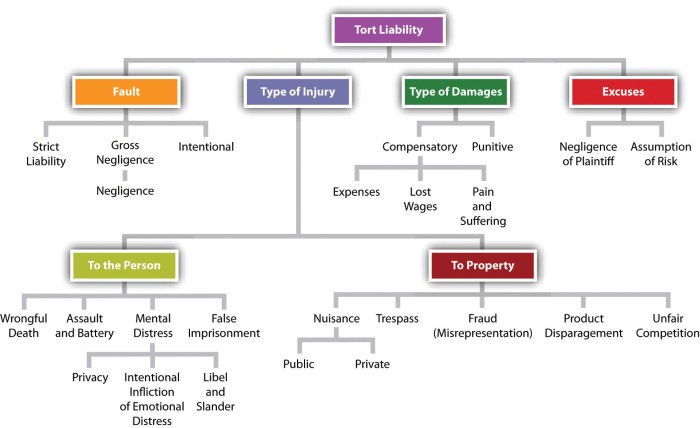
What is battery law sets the stage for this enthralling narrative, offering readers a glimpse into a story that is rich in detail and brimming with originality from the outset. Battery law, a fundamental concept in tort law, defines the legal boundaries of unwanted physical contact. It explores the complexities of intentional acts causing harm, examining the elements required to establish liability and the defenses available to those accused.
This exploration delves into the historical roots of battery law, tracing its evolution through centuries of legal precedent. We will unravel the core principles and legal concepts that form the foundation of this area of law, providing a comprehensive understanding of its scope and application.
Introduction to Battery Law

Battery law is a critical area of tort law that protects individuals from unwanted physical contact. It is a civil wrong that arises when one person intentionally causes harmful or offensive contact with another person without their consent. Battery law aims to deter individuals from engaging in harmful or offensive conduct and to compensate victims for the injuries they suffer.
Historical Evolution of Battery Law
The historical evolution of battery law can be traced back to the common law of England. In early English law, the concept of battery was closely tied to the idea of trespass. The law of trespass protected individuals from unauthorized intrusions on their property, including their bodies. Over time, the law of battery evolved to focus more specifically on the protection of personal integrity.
- In the 17th century, the English courts began to recognize the concept of “assault” as a separate tort from battery. Assault was defined as the threat of imminent harm, while battery was defined as the actual infliction of harm.
- The development of battery law in the United States was heavily influenced by English common law. However, American courts have also developed their own unique interpretations of the elements of battery.
- Throughout the 19th and 20th centuries, battery law continued to evolve in response to changes in society, such as the rise of industrialization and the increasing prevalence of personal injury claims.
Core Principles and Legal Concepts Underlying Battery Law
Battery law is based on a number of core principles and legal concepts, including:
- Intentional Act: The defendant must have acted intentionally in causing the harmful or offensive contact. This means that the defendant must have acted with the purpose of causing contact or with the knowledge that contact was substantially certain to occur.
- Harmful or Offensive Contact: The contact must be harmful or offensive to a reasonable person. This does not necessarily mean that the contact must cause physical injury. For example, an unwanted kiss or a slap on the face could constitute battery even if it does not cause physical harm.
- Lack of Consent: The contact must be without the plaintiff’s consent. This means that the plaintiff must not have agreed to the contact, either expressly or implicitly.
The elements of battery are: (1) an act by a defendant; (2) with intent to cause harmful or offensive contact; (3) harmful or offensive contact occurs; and (4) the contact is without the plaintiff’s consent.
Elements of Battery

To establish a battery claim, a plaintiff must prove the following elements:
- An act by the defendant that causes harmful or offensive contact.
- The contact must be intentional.
- The contact must be without the plaintiff’s consent.
Acts Constituting Battery
Battery is a broad tort, encompassing various actions that can result in harmful or offensive contact. These actions can range from physical assaults to more subtle forms of contact, such as spitting on someone or throwing a substance at them.
- Physical assault: This involves direct physical contact with the victim, such as punching, kicking, or shoving.
- Spitting: Even though it may seem minor, spitting on someone can be considered battery if it is done intentionally and without consent.
- Throwing objects: Throwing an object at someone, regardless of whether it actually hits them, can constitute battery if the act is intentional and the object is likely to cause harm or offense.
Defenses to Battery
While the elements of battery seem straightforward, defendants often raise defenses to negate liability.
- Consent: If the plaintiff consented to the contact, the defendant cannot be held liable for battery.
- Self-defense: A defendant may use reasonable force to defend themselves from an imminent threat of harm.
- Defense of others: A defendant may use reasonable force to defend a third party from an imminent threat of harm.
- Necessity: In certain situations, a defendant may be justified in using force if it is necessary to prevent a greater harm.
Types of Battery
Battery can be categorized based on the mental state of the person committing the act, leading to different legal consequences. The three primary types of battery are intentional battery, negligent battery, and strict liability battery.
Intentional Battery
Intentional battery occurs when a person acts with the intent to cause harmful or offensive contact with another person. This type of battery requires proof of both the intent to cause contact and the actual harmful or offensive contact.
For example, if someone punches another person in the face, intending to cause harm, it would be considered intentional battery.
Negligent Battery
Negligent battery occurs when a person acts negligently, causing harmful or offensive contact with another person. This type of battery requires proof of negligence, meaning the person failed to act with reasonable care.
For instance, if a doctor accidentally performs surgery on the wrong patient, it could be considered negligent battery.
Strict Liability Battery
Strict liability battery occurs when a person is held liable for harmful or offensive contact, even if they did not intend to cause harm or act negligently. This type of battery applies in situations where the activity itself is considered inherently dangerous.
For example, if a company manufactures a product that is defective and causes harm to a consumer, the company could be held strictly liable for battery.
- Intentional Battery:
- Intent: The person must have intended to cause harmful or offensive contact.
- Harmful or Offensive Contact: The contact must be harmful or offensive.
- Legal Consequences: The person who commits intentional battery can be held liable for damages, including pain and suffering, medical expenses, and lost wages.
- Negligent Battery:
- Negligence: The person must have acted negligently, failing to exercise reasonable care.
- Harmful or Offensive Contact: The contact must be harmful or offensive.
- Legal Consequences: The person who commits negligent battery can be held liable for damages, including pain and suffering, medical expenses, and lost wages.
- Strict Liability Battery:
- Inherently Dangerous Activity: The activity must be considered inherently dangerous.
- Harmful or Offensive Contact: The contact must be harmful or offensive.
- Legal Consequences: The person who commits strict liability battery can be held liable for damages, including pain and suffering, medical expenses, and lost wages.
Damages in Battery Cases: What Is Battery Law
When a person is found liable for battery, the court will determine the appropriate damages to compensate the victim for their injuries and losses. Damages in battery cases are intended to make the victim whole again, as much as possible, by providing financial compensation for the harm caused.
Types of Damages, What is battery law
The types of damages that can be awarded in battery cases fall into three main categories:
- Compensatory Damages: These are the most common type of damages awarded in battery cases. Compensatory damages are intended to compensate the victim for their actual losses, including medical expenses, lost wages, pain and suffering, and emotional distress.
- Punitive Damages: Punitive damages are awarded to punish the defendant for their egregious conduct and to deter others from engaging in similar behavior. These damages are not intended to compensate the victim for their losses but rather to punish the defendant for their wrongful actions. Punitive damages are typically awarded only in cases where the defendant’s conduct is particularly egregious, such as when the battery was intentional, malicious, or reckless.
- Nominal Damages: Nominal damages are awarded when the plaintiff has proven that the defendant committed a battery but has not suffered any actual harm. These damages are typically a small amount of money, such as $1, and are intended to acknowledge that the defendant’s actions were wrongful.
Factors Considered in Determining Damages
Courts consider various factors when determining the amount of damages to award in battery cases, including:
- The severity of the victim’s injuries: This includes both physical and emotional injuries. The more severe the injuries, the higher the damages awarded.
- The victim’s medical expenses: This includes the cost of treatment, medication, and rehabilitation.
- The victim’s lost wages: This includes the wages the victim lost as a result of their injuries.
- The victim’s pain and suffering: This includes the physical pain, emotional distress, and mental anguish the victim experienced as a result of the battery.
- The defendant’s conduct: This includes the intent of the defendant, the severity of the battery, and any aggravating factors.
- The defendant’s financial resources: This is considered when determining the amount of punitive damages to award.
Examples of Damages Awarded
Here are some examples of how damages have been awarded in past battery cases:
- In a case where a victim suffered a broken leg and lost six months of work due to a battery, the court awarded $100,000 in compensatory damages. This amount included $50,000 for medical expenses, $25,000 for lost wages, and $25,000 for pain and suffering.
- In a case where a victim was severely beaten and left with permanent injuries, the court awarded $5 million in compensatory damages and $10 million in punitive damages. The punitive damages were awarded because the defendant’s conduct was particularly egregious, and the court wanted to deter others from engaging in similar behavior.
- In a case where a victim was punched in the face but did not suffer any serious injuries, the court awarded $1,000 in nominal damages. This amount was awarded because the defendant committed a battery, but the victim did not suffer any actual harm.
Defenses to Battery Claims
In a battery lawsuit, the defendant may assert various defenses to avoid liability. These defenses aim to negate the elements of battery or demonstrate that the plaintiff’s claim is not valid. Here, we delve into common defenses used in battery cases.
Consent
Consent is a valid defense to battery claims. When a person consents to the contact, it is not considered battery. Consent can be expressed or implied.
- Expressed consent occurs when a person verbally or in writing agrees to the contact.
- Implied consent arises from the circumstances or from the conduct of the person.
For instance, a patient consents to a medical procedure by signing a consent form. Similarly, in a sporting event, players consent to physical contact within the rules of the game.
Self-Defense
Self-defense is a common defense to battery claims. It allows a person to use reasonable force to protect themselves from imminent harm. The use of force must be proportionate to the threat posed.
- Reasonable force refers to the amount of force that is necessary to protect oneself from harm.
- Imminent harm means that the threat of harm is immediate and likely to occur.
For example, if someone is attacked, they can use reasonable force to defend themselves. However, the use of excessive force, such as using a deadly weapon in a non-deadly situation, could be considered battery.
Defense of Others
Defense of others is similar to self-defense. It allows a person to use reasonable force to protect another person from imminent harm. The person defending others must reasonably believe that the other person is in danger and that the use of force is necessary.
- Reasonable belief means that the person defending others must have a reasonable basis for believing that the other person is in danger.
- Necessary force refers to the amount of force that is reasonably necessary to protect the other person from harm.
For example, if a person sees someone being attacked, they may intervene and use reasonable force to protect the victim.
Remedies for Battery
When a person commits battery, the victim may have several legal remedies available to them to seek redress for the harm they have suffered. These remedies aim to hold the perpetrator accountable, provide compensation for the victim’s losses, and deter future acts of violence.
Injunctions
Injunctions are court orders that prohibit a person from engaging in certain actions. In the context of battery, an injunction may be sought to prevent the perpetrator from further harming the victim. For example, a court may issue a restraining order against a person who has repeatedly assaulted their partner.
Criminal Prosecution
Battery is a criminal offense in most jurisdictions, and the victim may choose to pursue criminal charges against the perpetrator. The severity of the charges will depend on the nature and extent of the injuries inflicted. If convicted, the perpetrator may face a range of penalties, including fines, imprisonment, or both.
Civil Lawsuits
Victims of battery can also file civil lawsuits against the perpetrator to seek monetary damages for their injuries and other losses. These lawsuits are typically filed in state courts and can include claims for:
- Compensatory Damages: These damages are intended to compensate the victim for their actual losses, such as medical expenses, lost wages, and pain and suffering.
- Punitive Damages: These damages are awarded to punish the perpetrator for their egregious conduct and deter them from repeating their actions. They are typically awarded in cases where the battery was particularly violent or malicious.
Factors Considered by Courts
When determining the appropriate remedy in a battery case, courts consider various factors, including:
- Severity of the Battery: The severity of the injuries inflicted will be a major factor in determining the appropriate remedy. More serious injuries will likely result in more severe penalties for the perpetrator.
- Intent of the Perpetrator: The court will consider the perpetrator’s intent in committing the battery. If the battery was intentional and malicious, the court may impose more severe penalties.
- Criminal History: The perpetrator’s criminal history will also be considered. A perpetrator with a history of violence may face harsher penalties than a first-time offender.
- Victim’s Losses: The court will consider the victim’s losses, such as medical expenses, lost wages, and pain and suffering. These losses will be a major factor in determining the amount of compensatory damages awarded.
Examples of Remedies
- In a case where a man repeatedly assaulted his wife, a court issued a restraining order against him, prohibiting him from contacting her or going near her residence.
- In another case, a man who punched a stranger in a bar was charged with assault and battery and sentenced to six months in jail.
- In a civil lawsuit, a woman who was injured in a car accident caused by a drunk driver was awarded $1 million in compensatory damages for her medical expenses, lost wages, and pain and suffering.
Current Issues in Battery Law
Battery law, like many areas of law, is constantly evolving to address the changing nature of society and the impact of new technologies. This evolution presents both challenges and opportunities for legal professionals and individuals alike.
The Impact of Technology
The advent of new technologies, particularly in the digital realm, has raised new questions about the application of battery law. For example, the rise of social media has led to a significant increase in online harassment and cyberbullying, which can often involve verbal abuse, threats, and the dissemination of personal information. While these actions may not constitute physical contact, they can cause emotional distress and psychological harm, raising the question of whether they should be considered battery.
- Cyberbullying and Online Harassment: Online harassment, including cyberbullying, often involves the use of electronic communication to intimidate, threaten, or harass another person. While physical contact is not present, the emotional distress and psychological harm caused by these actions can be significant. Courts are grappling with whether these actions constitute battery, particularly when they involve the dissemination of personal information or images.
- Remotely Operated Devices: The development of remotely operated devices, such as drones and robots, raises questions about liability for battery when these devices are used to cause physical harm. For example, if a drone is used to deliver a physical blow, who is liable for the battery? The operator of the drone, the manufacturer, or both?
- Virtual Reality and Augmented Reality: As virtual reality (VR) and augmented reality (AR) technologies become more sophisticated, there is concern about the potential for these technologies to be used to inflict harm, either physically or emotionally. For example, a VR experience could be designed to simulate physical assault, or an AR application could be used to project images or sounds that cause psychological distress.
The Role of Social Media
Social media platforms have become ubiquitous, playing a significant role in our daily lives. While social media can be a powerful tool for communication and connection, it also presents unique challenges for battery law.
- Dissemination of Harmful Content: Social media platforms can be used to disseminate harmful content, such as images or videos of violent acts or threats of violence. This raises questions about the liability of social media companies for the content posted on their platforms.
- “Doxing” and the Publication of Private Information: “Doxing” involves the online publication of private information about an individual, often with the intention of causing harm or harassment. This practice can have serious consequences for the victim, including reputational damage, emotional distress, and even physical safety.
- Social Media Threats: Social media posts and messages can often contain threats of violence or harm. The legal implications of these threats, particularly when they are directed at specific individuals, are being actively debated.
Evolving Societal Norms
Societal norms are constantly changing, and these changes can have a significant impact on battery law. As society becomes more aware of the diverse experiences of individuals, there is a growing recognition of the need to protect people from all forms of harm, including emotional and psychological harm.
- Recognition of Emotional Distress: Courts are increasingly recognizing that emotional distress can be a serious consequence of battery, even in cases where physical contact is minimal or absent. This recognition is driven by a growing understanding of the impact of emotional abuse and trauma.
- Consent and Boundaries: The concept of consent is becoming increasingly central to battery law. As society becomes more aware of the importance of respecting personal boundaries, courts are placing greater emphasis on the requirement that any physical contact must be consensual.
- Protection of Vulnerable Groups: Battery law is also evolving to provide greater protection for vulnerable groups, such as children, the elderly, and individuals with disabilities. This evolution is driven by a growing recognition of the heightened risks of harm faced by these groups.
Final Review

Understanding battery law is crucial for navigating the complexities of personal injury claims and ensuring that individuals are protected from unlawful physical contact. This comprehensive exploration has provided insights into the elements of battery, its various types, and the available remedies. By delving into the nuances of this area of law, we gain a deeper appreciation for the importance of respecting personal boundaries and the legal framework that safeguards our physical integrity.
FAQ Corner
What are the penalties for committing battery?
Penalties for battery vary depending on the severity of the offense and jurisdiction. It can range from fines to imprisonment, and in some cases, civil lawsuits for damages.
Can a person be charged with battery for accidental contact?
Generally, accidental contact does not constitute battery as it lacks the element of intent. However, negligence may still apply in some situations.
What are the differences between battery and assault?
Assault involves the apprehension of imminent harmful or offensive contact, while battery involves the actual contact itself. Assault is the threat, while battery is the act.
Can a person be sued for battery if they acted in self-defense?
Self-defense is a valid legal defense to a battery claim if the force used was reasonable and necessary to protect oneself from imminent harm.
What are some examples of battery in everyday life?
Examples include punching, kicking, slapping, pushing, spitting, or any unwanted physical contact that causes harm or offense.





